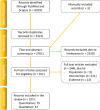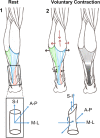In Vivo Strain Patterns in the Achilles Tendon During Dynamic Activities: A Comprehensive Survey of the Literature
- PMID: 37466866
- PMCID: PMC10356630
- DOI: 10.1186/s40798-023-00604-5
In Vivo Strain Patterns in the Achilles Tendon During Dynamic Activities: A Comprehensive Survey of the Literature
Abstract
Achilles' tendon (AT) injuries such as ruptures and tendinopathies have experienced a dramatic rise in the mid- to older-aged population. Given that the AT plays a key role at all stages of locomotion, unsuccessful rehabilitation after injury often leads to long-term, deleterious health consequences. Understanding healthy in vivo strains as well as the complex muscle-tendon unit interactions will improve access to the underlying aetiology of injuries and how their functionality can be effectively restored post-injury. The goals of this survey of the literature with a systematic search were to provide a benchmark of healthy AT strains measured in vivo during functional activities and identify the sources of variability observed in the results. Two databases were searched, and all articles that provided measured in vivo peak strains or the change in strain with respect to time were included. In total, 107 articles that reported subjects over the age of 18 years with no prior AT injury and measured while performing functional activities such as voluntary contractions, walking, running, jumping, or jump landing were included in this review. In general, unclear anatomical definitions of the sub-tendon and aponeurosis structures have led to considerable confusion in the literature. MRI, ultrasound, and motion capture were the predominant approaches, sometimes coupled with modelling. The measured peak strains increased from 4% to over 10% from contractions, to walking, running, and jumping, in that order. Importantly, measured AT strains were heavily dependent on measurement location, measurement method, measurement protocol, individual AT geometry, and mechanical properties, as well as instantaneous kinematics and kinetics of the studied activity. Through a comprehensive review of approaches and results, this survey of the literature therefore converges to a united terminology of the structures and their common underlying characteristics and presents the state-of-knowledge on their functional strain patterns.
Keywords: Achilles tendon; Aponeurosis; Dynamic activities; In vivo measurement; Sub-tendon; Tendon strain.
© 2023. The Author(s).
Conflict of interest statement
The authors declare that they have no competing interests.
Figures






References
Publication types
Grants and funding
LinkOut - more resources
Full Text Sources

